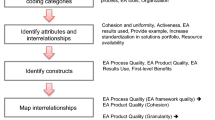Abstract
Organizations are increasingly concerned about business process model improvement in their efforts to guarantee improved operational efficiency. Quality assurance of business process models should be addressed in the most objective manner, e.g., through the application of measures, but the assessment of measurement results is not a straightforward task and it requires the identification of relevant indicators and threshold values, which are able to distinguish different levels of process model quality. Furthermore, indicators must support the improvements of the models by using suitable guidelines. In this paper, we present a case study to evaluate the BPMIMA framework for BP model improvement. This framework is composed of empirically validated measures related to quality characteristics of the models, a set of indicators with validated thresholds associated with modeling guidelines and a prototype supporting tool. The obtained data suggest that the redesign by applying guidelines driven by the indicator results was successful, as the understandability and modifiability of the models were improved. In addition, the changes in the models according to guidelines were perceived as acceptable by the practitioners who participated in the case study.














Similar content being viewed by others
References
Kettinger, W.J., Teng, J.T.C., Guha, S.: Business process change: a study of methodologies, techniques and tools. MIS Q. 21, 55–80
Weske, M.: Business Process Management: Concepts, Languages, Architectures, 1st edn. Springer, New York (2007)
Dumas, M., et al.: Fundamentals of Business Process Management. Springer, New York (2013)
Recker, J., Safrudin, N., Rosemann, M.: How novices model business processes. In: Proceedings of the 8th international conference on Business process management, pp. 29–44. Springer-Verlag, Hoboken, NJ, USA (2010)
Leopold, H., Smirnov, S., Mendling, J.: On the refactoring of activity labels in business process models. Inf. Syst. 37(5), 443–459 (2012)
Moody, D.: Theoretical and practical issues in evaluating the quality of conceptual models: current state and future directions. Data Knowl. Eng. 55, 243–276 (2005)
Sánchez-González, L., et al.: Toward a quality framework for business process models. Int. J. Coop. Inf. Syst. 22(01), 1350003 (2013)
de Oca, Moreno-Montes, et al.: A systematic literature review of studies on business process modeling quality. Inf. Softw. Technol. 58, 187–205 (2015)
Sánchez-González, L., et al.: Measurement in business processes: a systematic review. Bus. Process Manag. J. 16(1), 114–134 (2010)
García, F., et al.: Towards a consistent terminology for software measurement. Inf. Softw. Technol. 48, 631–644 (2005)
Yu-dong, Q., Ning, Q., Xie, X.-F.: Towards a preliminary ontology for conceptual model quality evaluating. In: International conference on web information systems and mining, pp. 329–334 (2010)
Mohagheghi, P., Dehlen, V., Neple, T.: Definitions and approaches to model quality in model-based software development: a review of literature. Inf. Softw. Technol. 51(12), 1646–1669 (2009)
Guceglioglu, S., Demirors, O.: Using software quality characteristics to measure business process quality. In: van der Aalst, W.M.P., Benatallah, B., Casati, F., Curbera, F. (eds.) Business Process Management. Lecture Notes in Computer Science, vol. 3649, pp. 374–379. Springer, Berlin (2005)
Rittgen, P.: Quality and perceived usefulneses of process models. In: SAC 10, proceedings of the ACM symposium on Applied computing (2010)
Satpathy, M., et al.: A generic model for assessing process quality. In: Proceedings of the 10th international workshop on new approaches in software measurement, pp. 94–110. Springer-Verlag (2000)
Matook, S., Indulska, M.: Improving the quality of process reference models: a quality function deployment-based approach. Decis. Support Syst. 47(1), 60–71 (2009)
Heravizadeh, M., Mendling, J., Rosemann, M.: Dimensions of business processes quality (QOBP). In: 6th internatioanl conference on business process management workshops (BPM workshops 2008) (2008)
Lindland, O.I., Sindre, G., Solvberg, A.: Understanding quality in conceptual modeling. IEEE Softw. 11(2), 42–49 (1994)
Becker, J., Rosemann, M., von Uthmann, C.: Guidelines of Business Process Modeling, in Business Process Management. Springer, Berlin (2000)
Yu-dong, Q., et al.: Analysis of contribution of conceptual model quality to software reliability. In: 2010 International conference on computer application and system modeling (ICCASM) (2010)
ISO/IEC, 9126–1, Software Engineering—Product Quality—Part 1: Quality Model (2001)
ISO/IEC, 25010, Systems and Software Engineering—System and Software Product Quality Requirements and Evaluation (SQuaRE)—System and Software Quality Models (2011)
Figl, K., Recker, J., Mendling, J.: A study on the effects of routing symbol design on process model comprehension. Decis. Support Syst. 54(2), 1104–1118 (2013)
Recker, J., Dreiling, A.: The effects of content presentation format and user characteristics on novice developers’ understanding of process models. Commun. Assoc. Inf. Syst. 28(6), 65–84 (2011)
Sweller, J.P., Chandler, P.: Why some material is difficult to learn. Cognit. Instr. 12(3), 185–223 (1994)
Reijers, H.A., et al.: Syntax highlighting in business process models. Decis. Support Syst. 51(3), 339–349 (2011)
Mendling, J., Strembeck, M., Recker, J.: Factors of process model comprehension—findings from a series of experiments. Decis. Support Syst. 53(1), 195–206 (2012)
Houy, C., Fettke, P., Loos, P.: Understanding understandability of conceptual models—what are we actually talking about? In: Proceedings of the 31st international conference on conceptual Modeling, pp. 64–77. Springer-Verlag, Florence, Italy (2012)
Sutcliffe, A., Kurniawan, S., Shin, J.E.: A method and advisor tool for multimedia user interface design. Int. J. Hum. Comput. Stud. 64, 375–392 (2005)
Kim, J., Lee, J., Choi, D.: Designing emotionally evocative homepages: an empirical study of the quantitative relations between design factors and emotional dimensions. Int. J. Hum. Comput. Stud. 59(6), 899–940 (2003)
Sharp, A., McDermott, P.: Workflow Modeling: Tools for Process Improvement and Application Development. A.H. Publishers, London (2001)
Mendling, J., Reijers, H.A., van der Aalst, W.M.P.: Seven process modeling guidelines (7PMG). Inf. Softw. Technol. 52(2), 127–136 (2010)
Sánchez-González, L., et al.: Quality Assessment of Business Process Models Based on Thresholds. In: Meersman, R., Dillon, T., Herrero, P. (eds.) On the Move to Meaningful Internet Systems: OTM 2010, pp. 78–95. Springer, Berlin (2010)
Mendling, J., et al.: Thresholds for error probability measures of business process models. J. Syst. Softw. 85(5), 1188–1197 (2012)
Sanchez-Gonzalez, L., et al.: Quality indicators for business process models from a gateway complexity perspective. Inf. Softw. Technol. 54(11), 1159–1174 (2012)
Cardoso, J.: Process control-flow complexity metric: an empirical validation. In: SCC‘06: Proceedings of the IEEE international conference on services computing, pp. 167–173 (2006)
OMG: Business process model and notation (BPMN) 2. http://www.omg.org/bpm (2011)
Rolón, E., et al.: Process modeling of the health sector using BPMN: a case of study. Healthinf 2, 173–178 (2008)
Mendling, J.: Metrics for Process Models: Empirical Foundations of Verification, Error Prediction, and Guidelines for Correctness. Springer, New York (2008)
Zweig, M., Campbell, G.: Receiver-operating characteristic (ROC) Plots: A fundamental evaluation tool in clinical medicine. Clin. Chem. 39(4), 561–577 (1993)
Bender, R.: Quantitative risk assessment in epidemiological studies investigating threshold effects. Biom. J. 41(3), 305–319 (1999)
Rolón, E., García, F., Ruiz, F.: Evaluation measures for business process models. In:Symposioum in applied computing SAC06 (2006)
van der Aalst, W.M.P., et al.: Workflow patterns. Distrib. Parallel Databases 14(1), 5–51 (2003)
Runeson, P., Höst, M.: Guidelines for conducting and reporting case study research in software engineering. Empir. Softw. Eng. 14, 131–164 (2009)
Yin, R.K.: Case Study Research, Design and Methods. Sage Publications, Beverly hills (2003)
Robson, C.: Real World Research: A Resource for Social Scientists and Practitioner-Researchers, 2nd edn. Blackwell Publishing, Malden (2002)
Benbasat, I., Goldstein, D.K., Mead, M.: The case research strategy in studies of information systems. MIS Q. 11(3), 369–386 (1987)
Acknowledgments
The authors would like to thank Jan Mendling for his support in research related to this study. This work has been developed under the projects: GEODAS-BC (Min. de Economía y Competitividad and Fondo Europeo de Desarrollo Regional FEDER, TIN2012-37493-C03-01) and INGENIOSO (PEII-2014-050-P), Junta de Comunidades de Castilla-La Mancha and FEDER.
Author information
Authors and Affiliations
Corresponding author
Additional information
Communicated by Prof. Antonio Vallecillo.
Appendix 1: Questionnaires of the case study
Appendix 1: Questionnaires of the case study
Questionnaire 1: Busines Process model “Incorporation of a new employee”
Let us imagine we want to analyze a BP model to understand and modify it. Indicate what proposed changes most affect the understandability and modifiability of the models. For example, if you think that the subprocess IT management, which is carried out by the immediate superior, has led the model to be more understandable/modifiable, choose this option.
-
1.
Using subprocesses such as “IT management”\({}^{1}\) which is composed of a group of related activities, instead of displaying all the activities\({}^{2}\) ...makes the model
-
\(\square \) Easier to understand or modify
-
\(\square \) Less easy to understand or modify
-
\(\square \) Neither of these

-
-
2.
Using an activity called “Manage revision in POH”\({}^{1}\) which is composed of the activities “Effectuate revision in POH” and “Receive results of POH”\({}^{2}\) ... makes the model
-
\(\square \) Easier to understand or modify
-
\(\square \) Less easy to understand or modify
-
\(\square \) Neither of these
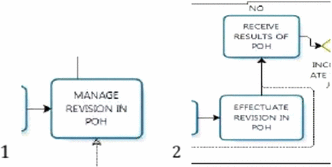
-
-
3.
Using decision nodes with the highest number of output possibilities, for example, the gateway “type of contract?” in the participant “correspondent direction” has 5 possibilities\({}^{1}\) instead of 4\({}^{2}\) (in the original model)... this makes the model
-
\(\square \) Easier to understand or modify
-
\(\square \) Less easy to understand or modify
-
\(\square \) Neither of these
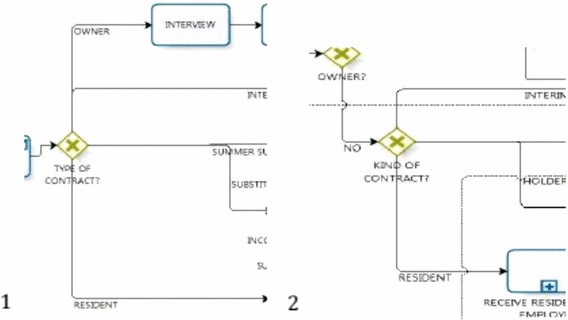
-
-
4.
Using “join” gateways accompanying “split” ones, for example, the join gateway which accompanied the split “type of contract?” in “new employee” participant... makes the model
-
\(\square \) Easier to understand or modify
-
\(\square \) Less easy to understand or modify
-
\(\square \) Neither of these
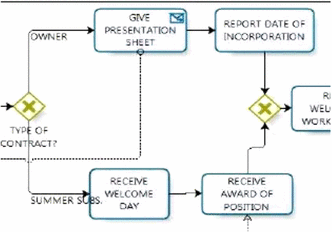
-
-
5.
Using gateways which include two questions at the same \(\hbox {time}^{1}\) (fusion of gateways). For example, the gateway “type of contract?”\({}^{2}\) implies taking a decision between owner or summer substitution, etc... this makes the model
-
\(\square \) Easier to understand or modify
-
\(\square \) Less easy to understand or modify
-
\(\square \) Neither of these
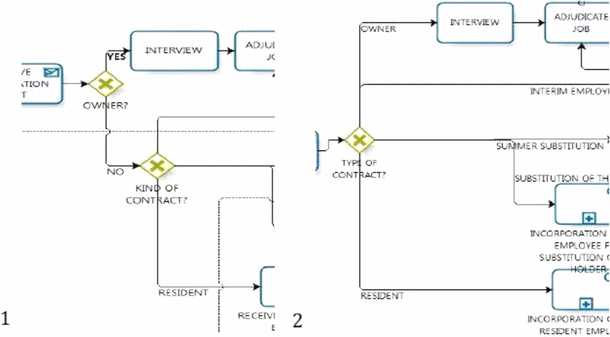
-
-
6.
Joining two activities\({}^{1}\) in only one\({}^{2}\) . That is the case of two activities called “Inform place of the work unit” and “Report standards and specific service agreement”, to make only one which is called “Inform of a) place of the work unit and b) standards and specific service agreement”... this makes the model
-
\(\square \) Easier to understand or modify
-
\(\square \) Less easy to understand or modify
-
\(\square \) Neither of these

-
-
7.
Using as many events as necessary, although there are more than the number of participants... makes the model
-
\(\square \) Easier to understand or modify
-
\(\square \) Less easy to understand or modify
-
\(\square \) Neither of these
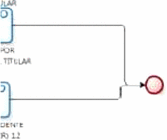
-
-
8.
Eliminating participants of “IT team”, “pharmacy service” and “Service of prevention of occupational hazards”...makes the model
-
\(\square \) Easier to understand or modify
-
\(\square \) Less easy to understand or modify
-
\(\square \) Neither of these

-
Questionnaire 2: Business Process models of “First consultation appointment” and “Appointment for examination with tests”
Let us imagine we want to analyze a BP model to understand and modify it. Indicate what proposed changes most affect the understandability or modifiability of models. For example, if you think that eliminating the participants “SAU” and “OGLE” makes the model easier to understand and modify, choose this option.
-
1.
Selecting the common part of subprocess “Appointment for examination with tests” and “First consultation appointment”, for example the activities “Go to SAU” or “Receive correspondent centre” in the participant “new employee” and moving them to the parent model “Appointments”, in order to indicate the particular activities of each subprocess in each subprocess ... makes the model
-
\(\square \) Easier to understand or modify
-
\(\square \) Less easy to understand or modify
-
\(\square \) Neither of these
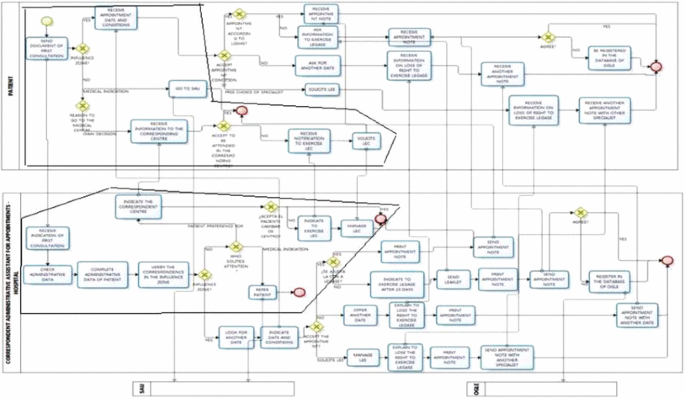
-
-
2.
Unifying the activity “Send document of first consultation” \({}^{1}\) in the subprocess “First consultation appointment” and the activity “Send referral note” \({}^{2}\)in the subprocess “Appointment for examination with tests” in only one (in common for both) called “send referral note”, indicating it in the parent process “Appointments”... makes the model
-
\(\square \) Easier to understand or modify
-
\(\square \) Less easy to understand or modify
-
\(\square \) Neither of these

-
-
3.
Unifying activities of “check patient address” in the participant “administrative assistant for appointments” in the subprocess “Appointment for examination with tests” and the activity “check administrative data” and “complete administrative data of patient” \({}^{1}\) in the process “First consultation appointment” as only one for both subprocesses, and moving it to the parent process “Appointments” ... makes the model
-
\(\square \) Easier to understand or modify
-
\(\square \) Less easy to understand or modify
-
\(\square \) Neither of these

-
-
4.
Using basic activities such as “print appointment note” \({}^{1}\) in the subprocess “First consultation appointment” in the participant “administrative assistant for appointments” instead of not including them...makes the model
-
\(\square \) Easier to understand or modify
-
\(\square \) Less easy to understand or modify
-
\(\square \) Neither of these

-
-
5.
Using repeated activities after the satisfaction of two different conditions \({}^{1}\) instead of indicating it only once \({}^{2}\), for example in the subprocess “First consultation appointment”... makes the model
-
\(\square \) Easier to understand or modify
-
\(\square \) Less easy to understand or modify
-
\(\square \) Neither of these

-
-
6.
Merging questions from two gateways into only one. The Gateway “Influence zone” and “Reason to go to medical centre” in the participant “Administrative assistant for appointments” in both subprocesses into only one gateway which includes both questions... makes the model
-
\(\square \) Easier to understand or modify
-
\(\square \) Less easy to understand or modify
-
\(\square \) Neither of these
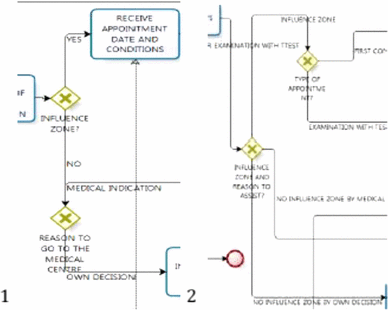
-
-
7.
Eliminating the participants “SAU” and “OGLE” in both subprocesses...makes the model
-
\(\square \) Easier to understand or modify
-
\(\square \) Less easy to understand or modify
-
\(\square \) Neither of these

-
-
8.
Using “join” gateways accompanying “Split” gateways, for example in “another date?” \({}^{1}\) in the subprocess “First consultation appointment...makes the model
-
\(\square \) Easier to understand or modify
-
\(\square \) Less easy to understand or modify
-
\(\square \) Neither of these
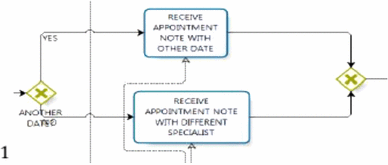
-
-
9.
Using a start event in all the process and subprocesses in each participant ...makes the model
-
\(\square \) Easier to understand or modify
-
\(\square \) Less easy to understand or modify
-
\(\square \) Neither of these

-
Rights and permissions
About this article
Cite this article
Sánchez-González, L., García, F., Ruiz, F. et al. A case study about the improvement of business process models driven by indicators. Softw Syst Model 16, 759–788 (2017). https://doi.org/10.1007/s10270-015-0482-0
Received:
Revised:
Accepted:
Published:
Issue Date:
DOI: https://doi.org/10.1007/s10270-015-0482-0



